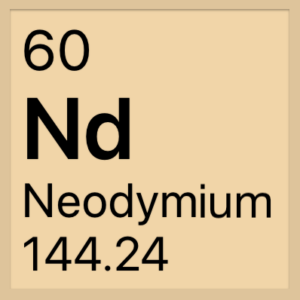An Element for a Modern World

Neodymium is a hard, slightly malleable silvery metal and is one of the more reactive lanthanides—a group of similar metallic elements numbered 57–71 in the top row of the annex below the main table. These elements in the annex, plus scandium (Sc) and yttrium (Y), are termed “rare earth elements” (REEs). Despite the name, most of these elements are relatively common in the Earth’s crust, but economically exploitable deposits are relatively sparse.
Neodymium is primarily mined as part of a conglomerate with other rare earth elements in mineral deposits. Today China supplies 70% of the world’s REEs, with new mines in Australia and a reopened U.S. mine contributing. Neodymium, combined with iron and boron, makes a very strong permanent magnet. This enabled the miniaturization of electronics such as loudspeakers, computer hard drives, mobile phones, and electronic automobile components. Neodymium magnets are also used in wind turbines, aeronautics and space.Other uses of neodymium include making a specialized glass used in protective goggles for welding and glass blowing, and in applications such as surgical lasers and laser pointers. Finally, it is used as a catalyst in polymerization reactions.
Challenges
Current recycling costs are high and infrastructure to recover REEs from electronic motors is underdeveloped. As important components of powerful batteries, magnets, photovoltaics, etc., REEs are enabling the clean energy economy. As demand for electric cars, wind turbines, solar panels and other high-tech devices grows, the supply pressure on REEs will also grow. What’s more, REEs are “critical resources” due to their important applications in industry and defense and because of the geopolitical risk of the supply chain being concentrated in primarily one country, namely China.
Solutions
Chemists are coming up with viable methods for recovering RREs while researching alternatives to neodymium use in magnets. As individuals, we can think twice before upgrading or buying new electronics while recycling or reusing the old ones — it all comes back to the 3Rs of recycling!
